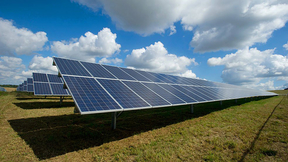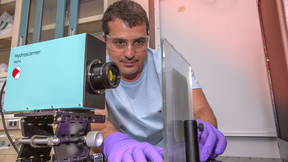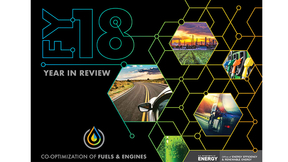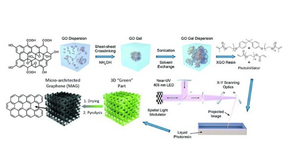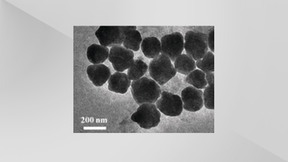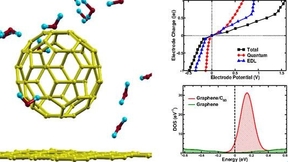Back
Lawrence Livermore National Laboratory (LLNL), California State University, Bakersfield (CSUB) and the Livermore Lab Foundation (LLF) have signed an agreement to collaborate on advanced and clean-energy technologies, research opportunities and community partnerships that have the potential to shape the future of energy in the state and bring high-quality jobs to the region…
A collaboration including scientists from Lawrence Livermore National Laboratory (LLNL), Sandia National Laboratories, the Indian Institute of Technology Gandhinagar and Lawrence Berkeley National Laboratory has created 3-4 nanometer ultrathin nanosheets of a metal hydride that increase hydrogen storage capacity. The research appears in the journal Small. There is a need…
Room temperature ionic liquids (ILs), a special class of molten salts, promise far greater electrochemical performance compared to conventional aqueous solutions due to a suite of novel and tunable properties. Over the past two decades, ILs have been explored as a means of improving a range of different technologies, from energy storage and conversion to catalysis to…
Lawrence Livermore National Laboratory (LLNL) researchers, in collaboration with Pennsylvania State University (PSU) and Idaho National Laboratory (INL), have designed a new process, based on a naturally occurring protein, that could extract and purify rare earth elements (REE) from low-grade sources. It could offer a new avenue toward a more diversified and sustainable…
Capacitive deionization (CDI) is an emerging class of water desalination technologies that use cyclic charging and discharging of electrodes to reduce or enrich the salinity of incoming water. The desalination characteristics of CDI are strongly influenced by the resistive components of the system. To better understand this process, a team of Lawrence Livermore National…
A team of Lawrence Livermore National Laboratory (LLNL) scientists and collaborators from the University of California, Santa Cruz (UCSC) and Sun Yat-Sen University have developed a new class of aerogel electrodes with a simultaneous boost in energy and power density. The research could be a boon for the energy storage industry. “This is the first example in which we were…
To help increase the U.S. supply of rare earth elements, a Critical Materials Institute team led by Lawrence Livermore National Laboratory (LLNL) is using microbe beads to recover rare earth elements from consumer electronic waste. The team developed a scalable biosorbent material – a microbe-embedded polymer – by combining material science with microbiology. The research…
While ions adsorbed on carbon electrodes can vary in size and shape, when it comes to selectivity and energy storage, size really does matter. In an effort to boost energy storage and water desalination technologies, Lawrence Livermore National Laboratory (LLNL) scientists found that capacitive performance and ion selectivity of porous carbons is controlled by a complex…
While 3D printing at the nanoscale — producing intricate features orders of magnitude smaller than the width of a human hair — has significant potential in industry and commercial applications, wide adoption has been impractical because of the slow speed and low throughput of the most widely used nanoprinting technique, two-photon lithography (TPL). But in the latest issue…
Not all nanopores are created equal. For starters, their diameters vary between 1 and 10 nanometers (nm). The smallest of these nanopores, called Single Digit Nanopores (SDNs), have diameters of less than 10 nm and only recently have been used in experiments for precision transport measurements. A team of Lawrence Livermore National Laboratory (LLNL) scientists and…
Nitrate is a troublesome groundwater contaminant that is mainly caused by fertilizer runoff on farmlands. Many wells in agricultural regions exceed the EPA limit for nitrate in drinking water, and without an economical treatment option the water is unfit for potable use. But Lawrence Livermore National Laboratory (LLNL) and Stanford University researchers have developed a…
Lawrence Livermore researchers and collaborators at the University of Texas at El Paso have developed a concept that allows the integration of the characteristic properties of fullerene in 3D graphene networks. In the study, the team optimized the interaction between 3D graphene networks and fullerenes, specifically in the context of stability and charge transfer in an…
Transparent electrodes are a critical component of solar cells and electronic displays. To collect electricity in a solar cell or inject electricity for a display, you need a conductive contact, like a metal, but you also need to be able to let light in (for solar cells) or out (for displays). Metal is opaque, so the current techniques use metal oxides, most often indium…
Lawrence Livermore National Laboratory (LLNL) researchers have posted another standout year securing major grants through the Department of Energy’s (DOE) Technology Commercialization Fund (TCF). During the program’s first two years, in 2016 and 2017, Lab researchers received only two of the larger cooperative development grants – one each year. In 2018, they garnered…
Three years after embarking upon a rigorous evaluation of a pool of more than 400 candidates, researchers with the Co-Optimization of Fuels & Engines (Co-Optima) initiative have identified six blendstocks from two chemical families that exhibit the greatest potential to dramatically increase efficiency when combined with petroleum-based fuels in boosted (or…
Whether you’re busy at work or lounging around at home, indoor air quality probably isn’t anywhere on the list of things on your mind. But numerous studies have shown that the buildup of carbon dioxide in environments such as office buildings, schools and homes can lead to increased health issues and a decrease in productivity, decision-making and cognitive performance. A…
An article entitled “Additive Manufacturing of Complex Micro-Architected Graphene Aerogels” (doi: 10.1039/c8mh00668g) is featured among the most popular articles published by Materials Horizons in 2018. Materials Horizons is positioned as “the new home for rapid reports of exceptional significance on innovative materials.” The paper describes the fabrication of architected…
A paper by Livermore researchers, in partnership with researchers at Brown University, has been designated a “hot paper” by the journal Angewandte Chemie. In this article, the authors describe a new technique to synthesize samarium-based nanomagnets and align them in a magnetic field to improve their performance. These show the highest saturation magnetization to date for…
Typically, superlattices—faceted crystals composed of nanocrystal building blocks—have been made using slow evaporative techniques that often take days to weeks to form highly crystalline solids. This process is difficult to control, which has made it hard to systematically tune film properties and has hindered quantitative study of the assembly process. To overcome these…
Understanding and controlling the electrical response at a complex electrode–electrolyte interface is key to the development of next-generation supercapacitors and other electrochemical devices. While it is largely acknowledged that the capacitive performance of these devices is governed by both the quantum capacitance of the electrode and the electric double layer…

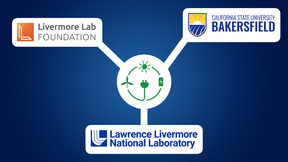
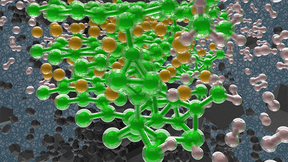
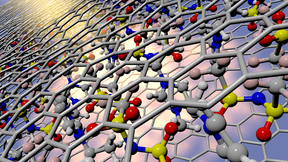

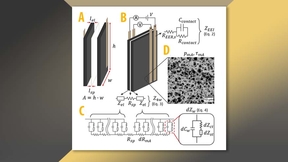

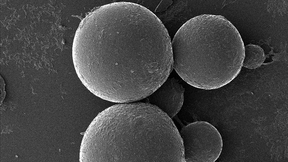


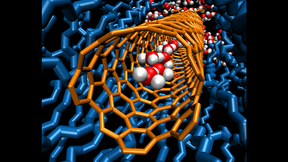

![ACS journal cover of [60]fullerene monoadduct physisorbed on a graphene network](https://contenthub.llnl.gov/sites/contenthub/files/styles/scaled_16_9_ratio_at_288x162/public/2022-02/2019-08-27_applied-materials-cover.jpg?itok=I48wP8px)
